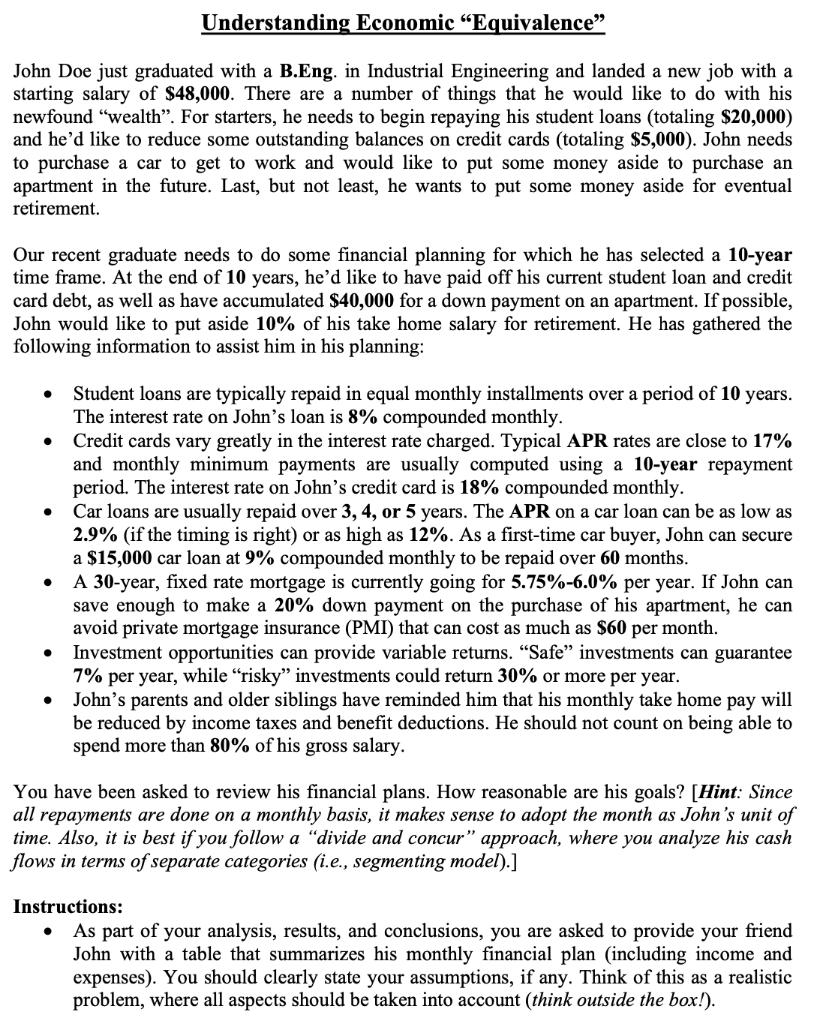Answered step by step
Verified Expert Solution
Question
1 Approved Answer
Understanding Economic Equivalence John Doe just graduated with a B.Eng. in Industrial Engineering and landed a new job with a starting salary of $48,000.


Understanding Economic "Equivalence" John Doe just graduated with a B.Eng. in Industrial Engineering and landed a new job with a starting salary of $48,000. There are a number of things that he would like to do with his newfound "wealth". For starters, he needs to begin repaying his student loans (totaling $20,000) and he'd like to reduce some outstanding balances on credit cards (totaling $5,000). John needs to purchase a car to get to work and would like to put some money aside to purchase an apartment in the future. Last, but not least, he wants to put some money aside for eventual retirement. Our recent graduate needs to do some financial planning for which he has selected a 10-year time frame. At the end of 10 years, he'd like to have paid off his current student loan and credit card debt, as well as have accumulated $40,000 for a down payment on an apartment. If possible, John would like to put aside 10% of his take home salary for retirement. He has gathered the following information to assist him in his planning: Student loans are typically repaid in equal monthly installments over a period of 10 years. The interest rate on John's loan is 8% compounded monthly. Credit cards vary greatly in the interest rate charged. Typical APR rates are close to 17% and monthly minimum payments are usually computed using a 10-year repayment period. The interest rate on John's credit card is 18% compounded monthly. Car loans are usually repaid over 3, 4, or 5 years. The APR on a car loan can be as low as 2.9% (if the timing is right) or as high as 12%. As a first-time car buyer, John can secure a $15,000 car loan at 9% compounded monthly to be repaid over 60 months. A 30-year, fixed rate mortgage is currently going for 5.75%-6.0% per year. If John can save enough to make a 20% down payment on the purchase of his apartment, he can avoid private mortgage insurance (PMI) that can cost as much as $60 per month. Investment opportunities can provide variable returns. "Safe" investments can guarantee 7% per year, while "risky" investments could return 30% or more per year. John's parents and older siblings have reminded him that his monthly take home pay will be reduced by income taxes and benefit deductions. He should not count on being able to spend more than 80% of his gross salary. You have been asked to review his financial plans. How reasonable are his goals? [Hint: Since all repayments are done on a monthly basis, it makes sense to adopt the month as John's unit of time. Also, it is best if you follow a "divide and concur" approach, where you analyze his cash flows in terms of separate categories (i.e., segmenting model).] Instructions: As part of your analysis, results, and conclusions, you are asked to provide your friend John with a table that summarizes his monthly financial plan (including income and expenses). You should clearly state your assumptions, if any. Think of this as a realistic problem, where all aspects should be taken into account (think outside the box!). Students are strongly encouraged to use MS Excel, whenever appropriate, but that's not necessary. If Excel is used, however, please attach the results to your report, as appropriate (and submit an electronic copy of the Excel Sheet). Students should clearly explain and show their work regardless of the approach chosen.
Step by Step Solution
★★★★★
3.34 Rating (148 Votes )
There are 3 Steps involved in it
Step: 1
Lets calculate the monthly amounts to be paid from Johns salary towards the repay...
Get Instant Access to Expert-Tailored Solutions
See step-by-step solutions with expert insights and AI powered tools for academic success
Step: 2

Step: 3

Ace Your Homework with AI
Get the answers you need in no time with our AI-driven, step-by-step assistance
Get Started


